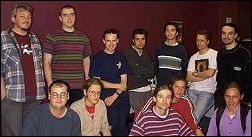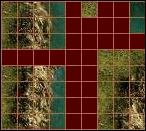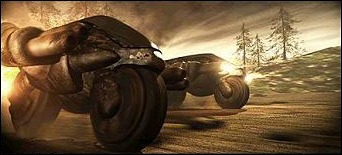KKND 2: Krossfire Development Diary
Part 1
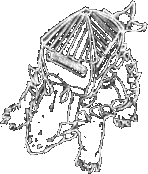 Australia’s Beam Software is best known for their real-time strategy game Krush, Kill, and Destroy, better remembered as KKND. Sure, it was one of the first Clone & Conquer games, but hey, it was a pretty good clone. Looking to build on that success, Beam has been developing KKND2: Krossfire, a game that looks to bring the original up to late 1990s levels of features and gameplay.
Australia’s Beam Software is best known for their real-time strategy game Krush, Kill, and Destroy, better remembered as KKND. Sure, it was one of the first Clone & Conquer games, but hey, it was a pretty good clone. Looking to build on that success, Beam has been developing KKND2: Krossfire, a game that looks to bring the original up to late 1990s levels of features and gameplay.
Just how does a company go about producing a game like this? Well, Judy Routt, a spokesperson for Beam and avid observer of the development process, provided us with this diary she kept of the various milestones the KKND2 team has passed through as they worked on the game. It’s a pretty funny tale, all things considered, and even though this is provided by the developer (i.e., it’s not written by us cynical journalist types), it’s got some good insights into the development process. Enjoy.
It’s going to be more a record of milestones than of day-to-day activities in the KKND room as I am observer and chronicler rather than a member of the team. Why did I get this job? Well, the Diary was my suggestion and folks said “Great idea, Judy—you can do it then!” Hmmm, maybe in the coming weeks I’ll regret my big mouth, but I don’t think so.
So, I guess I’ll start by describing the team and the project. Justin Halliday’s in charge of the team—he sets milestones and makes executive decisions of what to add or take out of the design. He is a pretty hands-on Producer and pretty cluey, so nothing gets past him.
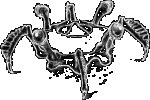 Craig Duturbure’s the designer. He’s written and rewritten (and rewritten again) the document which is the project’s bible. He’s worked out the back story, what all the units will be and all the new functions of the game. The design document is a veritable tome. So, this is the first milestone: the document is pretty much finalized. Craig has been working feverishly for quite a long while to complete the final unit design—the trickiest part is, I gather, to make the units’ cost and capabilities kind of balance so that no one unit is too kick-ass and no one side is superior.
Craig Duturbure’s the designer. He’s written and rewritten (and rewritten again) the document which is the project’s bible. He’s worked out the back story, what all the units will be and all the new functions of the game. The design document is a veritable tome. So, this is the first milestone: the document is pretty much finalized. Craig has been working feverishly for quite a long while to complete the final unit design—the trickiest part is, I gather, to make the units’ cost and capabilities kind of balance so that no one unit is too kick-ass and no one side is superior.
Let me tell you in broad brushstrokes about the KKND2 design. The game will incorporate a third side—the Series 9. The story goes that before the great war of 2079 there were nine separate series of robots created to carry out the menial tasks in life. The nuclear missiles of the great war were directed at the cities, slagging all city-dwelling robots but leaving the agricultural Series 9 robots intact. After the war the Series 9 went completely berserk, destroying all the remaining series 5 - 8 robots who threatened their natural outback existence. These robots have come upon the two factions of humanoids occupying the Earth and are now warring with both sides.
Also decided by Craig is that that KKND2 will now include amphibious units which are capable of dishing out death over both land and sea, and aerial units—three types for each army: fighters, bombers, and unit transports. “Orange Krush” is the working title for KKND2, however to me it sounds too much like a flavoured crushed ice drink! Hmmm!
Okay, back to the team members. Dan Tonkin, Toby Charlton, Jeremy Kupsch and John Tsiglev are the project’s artists. John is responsible for bringing the backgrounds to life, and the other three will work on the enormous number of sprites that will be required. Shane Lontis, Paul Baulch, Andrew P. Scott and Louis Solomon are going to be programming KKND2. Andrew’s doing unit programming, Shane is lead programmer and gets to do such things as graphics routines and Paul will program the computer player, but all of them get to do other things too. Louis is general Windows programming guru and is also going to be doing the network coding to make KKnD2 play well over a TCP/IP link. That seems like one of the toughest assignments.
Okay, those are the core team members. Also involved will be Damien Borg, who’ll do the front-end art, and Brian Uniacke, Greg Johnson and Rowan Summers who’ll assemble the mission maps when the time comes. Marshall and Gavin Parker are starting work on the music and sound effects and I have no idea who will get to do the missions—there’s talk of an internal competition, which would be fun.
So, that’s pretty much everyone. Next instalment I’ll have more details on how the game’s starting to look as code and art begin to take shape.
Part 2
 Wow! I just checked some of the new backgrounds for KKnD2. Shane has some of the graphic routines up and running, and John has put together some great high-colour backgrounds. John creates the backgrounds as “tiles” of terrain with different features, and kind of stamps them onto the map area and mattes together the edges of the tiles (which mostly they don’t need). The result is seamless and stunning—this kicks butt over the original KKND art. They’ve got some of the map areas animating - in particular they have up and running a truly cool volcano spurting out bubbles of hot lava, and the oil patches bubble away all on their own. The ripples across the water make it look so crisp and clear that you could jump right in.
Wow! I just checked some of the new backgrounds for KKnD2. Shane has some of the graphic routines up and running, and John has put together some great high-colour backgrounds. John creates the backgrounds as “tiles” of terrain with different features, and kind of stamps them onto the map area and mattes together the edges of the tiles (which mostly they don’t need). The result is seamless and stunning—this kicks butt over the original KKND art. They’ve got some of the map areas animating - in particular they have up and running a truly cool volcano spurting out bubbles of hot lava, and the oil patches bubble away all on their own. The ripples across the water make it look so crisp and clear that you could jump right in.
There are more varied terrain types in this new KKND. The Highland areas, which are largely complete, now include densely forested areas as well as large tracts of green and more marshy or swampy areas. Desert areas now have sheer quarried cliffs, sand dunes and impassable rifts. The new Urban terrain will have crumbling city blocks and broken roads, aqueducts and flattened slagged expanses.
 I have noticed that the new backgrounds also include remnants from the battles that took place in the original KKND, including old burnt-out outposts and even bits of old crab claws and tank treads. Quicksand may be a problem in the marshy Highland areas, threatening to swallow up infantry and even small vehicles without a trace. Bridges can be blown up in KKND2, which can lead to tactical advantage or stalemate.
I have noticed that the new backgrounds also include remnants from the battles that took place in the original KKND, including old burnt-out outposts and even bits of old crab claws and tank treads. Quicksand may be a problem in the marshy Highland areas, threatening to swallow up infantry and even small vehicles without a trace. Bridges can be blown up in KKND2, which can lead to tactical advantage or stalemate.
Another cool feature in KKnD2 is the effect that different terrains will have on unit speed and accessibility. For example all ground units will travel at a good speed while on roads but some will slow down considerably on sand. The terrain is 3D, so that Infantry will be able to hide from the enemy behind clumps of vegetation and pounce on them in ambush, and line of sight will be a real issue.
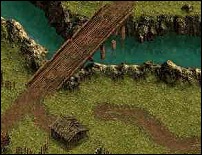 It’s been decided that the way the sprite art is to be split up is that each artist will be made responsible for one of the three armies. Dan as lead artist got to claim the Survivors, Jeremy took the Evolved, and Toby grabbed the Series 9. I reckon Toby’s going to have the best time of it, as he gets to design the whole race from scratch. Craig’s given rough guidelines for what sorts of looks he’d like to see but I think if Toby comes up with something great, he can draw them any way he wants. There are going to be new units for the other two races, but they’ll be at least somewhat stylistically constrained by the art from the original KKND.
It’s been decided that the way the sprite art is to be split up is that each artist will be made responsible for one of the three armies. Dan as lead artist got to claim the Survivors, Jeremy took the Evolved, and Toby grabbed the Series 9. I reckon Toby’s going to have the best time of it, as he gets to design the whole race from scratch. Craig’s given rough guidelines for what sorts of looks he’d like to see but I think if Toby comes up with something great, he can draw them any way he wants. There are going to be new units for the other two races, but they’ll be at least somewhat stylistically constrained by the art from the original KKND.
The sprites are going to be 8-bit, so they’ll have more colours than in the original KKND and on that alone should look much better than the old ones. Shane has been working on sprite routines but there’s not a lot to see yet.
Bantered about as a possible name for KKND2 is Fight Unlimited. Sounds like an arcade-style fighting game. We’ll see how long this one lasts.
Part 3
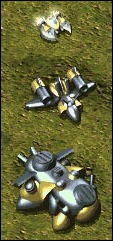 It’s been decided that units for the Survived and Evolved will have altered (or perhaps “evolved”) since the original KKND, now 40 years in the past, to suit the background and ideology of the two races—for example, the Evolved now only use trained creatures and are abandoning mechanical units altogether. So, now they’ll have a Bull-Ant Tanker instead of a normal Oil Tanker. And with the inclusion of a HUGE unit for each side, amphibious and aerial units, there are a whole lot of new units to look forward to. I think the concepts of these units—such as the Death Hippo and the Pteranodon—are pretty cool!
It’s been decided that units for the Survived and Evolved will have altered (or perhaps “evolved”) since the original KKND, now 40 years in the past, to suit the background and ideology of the two races—for example, the Evolved now only use trained creatures and are abandoning mechanical units altogether. So, now they’ll have a Bull-Ant Tanker instead of a normal Oil Tanker. And with the inclusion of a HUGE unit for each side, amphibious and aerial units, there are a whole lot of new units to look forward to. I think the concepts of these units—such as the Death Hippo and the Pteranodon—are pretty cool!
After reading the design concepts for the units, I went and bothered the artists to see how they were going. Well, they were going great guns - not helped, of course, by my endless requests to see more. But I liked what I saw—I think they’re really imaginatively thought out. These little guys careened across the screen like they were alive—that’s half a dozen frames per animation—that’s a lot of precise detail work, especially on the really tiny guys—it’s a pixel by pixel slog.
The sprites for all three races are easily distinguishable, not only because they are color-coded—blue for Survivors, red for Evolved and yellow for the Series 9—but also because they have a distinctive visual style due, in part I’m sure, to the fact that each race is being created by a different artist. Toby’s Series 9 units and buildings tend towards a dark matt metallic colour, with an emphasis on tubes and squat cylinders. Jeremy’s Evolved art shows the race’s reliance on giant ribcages of long-extinct animals to construct their red and ivory dwellings. Dan’s Survivor buildings have a bit more shine to them, and tend to shy away from the tubes-and-cylinder look favoured by the S9, opting more often for the practicality of flat planes in their structures. The infantry of the different races are easily distinguishable—the Series 9 are robots: sometimes droid-like and sometimes mech-like; the Evolved look more and more like beasts with their snouted faces and odd-coloured skin; and the Survivors, well, they still look like humans (and it’s a good thing too).
Although there are new units in both the Survivors’ and the Evolved’s camp, it’s the Series 9 units that are generating the most interest. They have weird alien-looking buildings and vehicles and “kill everything that moves” ‘tude. And although the infantry-type units do not regenerate like the veteran units of the Survivors and Evolved (you knew they did that, right?) they are much tougher than their counterparts in the other two armies. And they have funny metallic voices.
This week Shane has implemented translucency effects for explosions and some other things. What it means, simply, is that you can now see the terrain or units or whatever beneath the explosion. It’s a neat piece of coding, as you have to meld the terrain colours with the animation of the explosion to get this effect. It seems such a little detail, but things like this actually makes a real difference to the look of the game, changing it from a 2D map to a 3D experience! Shadows use this effect as well. Especially cool are the shadows for aerial units—the game’s perspective means that they appear a great distance from the actual units, emphasizing just how high above the ground the aerial units are flying. Shadows on the water are good too, but it’s the way ripples and splashes are generated when amphibious units swish through the water that make these units so cool. These simple effects make a great impact on the realistic look and feel of the game.
They’re talking about naming KKND2 “Karavan of Karnage.” Oh puleez! Send in the Klowns! Will this naming silliness never end? One day I’ll write a treatise “On the Subtitling of Computer Games” but not today.
Part 4
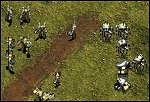 This week I checked out what some of the programmers have been up to. Programming seems to be the great unsung end of computer games creation in that its results are not very tangible without the more spectacular graphical side of things. As a programmer you can bang your head against a problem for literally months and not have too much to show for your time at the end (except to other programmers who are probably going to be completely blown away by the neat piece of code you’ve wrought).
This week I checked out what some of the programmers have been up to. Programming seems to be the great unsung end of computer games creation in that its results are not very tangible without the more spectacular graphical side of things. As a programmer you can bang your head against a problem for literally months and not have too much to show for your time at the end (except to other programmers who are probably going to be completely blown away by the neat piece of code you’ve wrought).
Andrew has implemented unit path finding, and it is markedly improved over the original game, especially for the bigger units. It checks methodically for clear line-of-sight in all of eight compass directions, retracing its steps when it hits an obstruction. It also checks the path width to ensure those large vehicles don’t get stuck in narrow corridors that foot troops pass through with no trouble.
Paul has been working on the Fog of War. In KKND2 you now have the option to choose to obscure terrain you’ve covered but aren’t currently occupying. The distant terrain appears as your units last saw it—the landscapes only—but greyed out to indicate that you can’t be sure if anything new has appeared there. Fog of War mode obviously makes the game harder, but it’s optional. The way in which the terrain is revealed is more aesthetically pleasing too. In the original KKND, terrain was revealed in a kind of a square. In KKND2 it’s more even and circular.
In the original KKND the landscape started off blackened out, and you could reveal the lay of the land only by heading out to explore it. Now that black “shroud” is an optional feature, so you can make the game easier as well as more difficult with these new options.
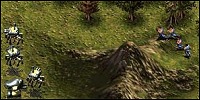 Line of sight is now a fact of life, making 3D terrain a reality. Obstacles and undulations in the landscape can block a unit’s view of the surrounding area—areas the unit can’t see directly are fogged out and any movement in those areas is undetectable. You can see and fire down from cliffs but you can’t fire up from below them, unless you have special artillery. Holding the high ground is now an advantage that needs to be seized!
Line of sight is now a fact of life, making 3D terrain a reality. Obstacles and undulations in the landscape can block a unit’s view of the surrounding area—areas the unit can’t see directly are fogged out and any movement in those areas is undetectable. You can see and fire down from cliffs but you can’t fire up from below them, unless you have special artillery. Holding the high ground is now an advantage that needs to be seized!
Louis is working on the network code to improve the response of network or Internet games so that KKND2 can be played effectively over a TCP/IP link as requested by KKNDers everywhere. It’s not easy coding but everyone’s confident that if anyone can do a good job of it, Louis can. Keeping the packet size small is not a problem—it was latency that tripped us up in the original KKND. KKND2 will stream packets so that it always has a queue of them to process. This way missing packets are more likely to arrive before their absence affects the performance of the game, even on slower networks. It’s missing packets on a slow network that causes the gameplay to become jerky and slow. Louis and Justin debated about whether KKND2’s latency solution amounts to loose synchronization over KKND’s tight synchronization. Louis says no. I conclude that Louis’ solution is deemed an original solution and no more textbook comparisons are made.
Programmers Matt and Alex have been pulled off other projects to work on the KKND2 Mission Editor, which has been the most-requested addition to KKND since we first released the game. You will be able to fiddle with the staples of the game using the mission editor, which is designed to be comprehensive and easy to use. You can create your own maps, place units and buildings, import your own map tiles, and set start and victory conditions on your own missions. Everything, in short, that the imaginative and enterprising real-time strategist could wish to play around with in the game. Matt, ever enthusiastic, assures me that it’s almost complete—another few weeks at most and it will be done. It will be a separate utility from the main game, so you would run it, save your new parameters and then run KKND2.
For a brief while this week, the name “Industrial Revolution” was considered for KKND2. “Agricultural Revolution” might have been more appropriate….
Part 5
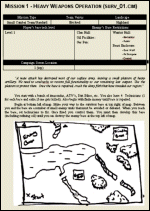 Well, with the game creation process well underway—with the game engine semi-working—the next step is to check the balance of units, to make sure one side or unit is not more powerful necessarily than another. The best way to do this, perhaps obviously, is to create missions, and tweak mission and unit properties until the balance is deemed to be right.
Well, with the game creation process well underway—with the game engine semi-working—the next step is to check the balance of units, to make sure one side or unit is not more powerful necessarily than another. The best way to do this, perhaps obviously, is to create missions, and tweak mission and unit properties until the balance is deemed to be right.
First things first: we need missions.
A little while back, Justin put together a mission design competition open to Beamers and their friends and family. The competition outline contained specifications for all the units in the game—although things will still be changed, even now—and we were encouraged to submit missions with the modest enticement of seeing our own mission in the final game and, for the best overall mission, a 3Dfx video card. Well, that encouraged me! I submitted two missions and although I didn’t win the big prize, one of my missions will make it into the game, so I’m satisfied.
Now the mission outlines have been parcelled out to the level designers - Brian, Greg and Rowan—and Justin himself so they can turn our ideas into actual missions. John has created the backgrounds for KKND2 in a series of map “tiles” and these are what’re being used to build the mission maps. First, the sketches from the mission designs are interpreted and scaled up to create a map large enough for the mission - the mission maps can vary considerably in size. Then, after the important details are entered, the map compositors have to flesh out the maps with interesting features, alternative routes and potential ambush points so any important paths appear no more important or interesting than the rest of the map.
The map building work is done in two layers, the first that units can walk or move in front of, and the second which units must move behind. It was at the stage I realized this two-level process was taking place that I really appreciated the work John had done—rooftops were created separately from the bottoms of buildings, and yet they have to mesh together perfectly. Even when different roofs are placed on the same building walls, they still have to mesh perfectly. The amount of pixel-perfect work involved in making these tiles has been enormous! Even with this work, the designers have to ensure edges are smoothed, parts of tiles overwritten and tiles mirrored in order to achieve a map that has no discontinuities and looks (and acts) like realistic terrain.
Once the maps are compiled, the designs are interpreted for important points, such as the tech level the enemy can attain, and what units or buildings each team begins the game with. Once that is clarified, the designers add to the maps enemy and player buildings and oil wells that are in existence when the mission begins, and then run the mission real-time, adding more units, enemies, terrain adjustments and so forth as they go. The order of unfolding events might be changed to vary the difficulty of the mission, and the aim of the designer is to create something that’s very playable and compelling, while being far from a cakewalk. I’ve been watching Rowan construct a mission from a design just now. He says he tries to make enemy attacks arrive from unexpected directions, and tries to outthink himself, giving the enemy plenty of terrain opportunities for ambush and so forth. It sounds like intense brainwork but a lot of fun—how could you pass up the opportunity to play games—and make them better—and get paid for it?
So, they were talking about Kollateral Damage as a name for KKND2. The best of a bad lot so far. But Marketing is rejecting it because “not everyone knows what ‘collateral’ means.” Can you believe that?
Part 6
I’ve been talking to the team about what makes KKND2 different from its previous incarnations. First off we talked about the big things, like the new units and new race, as I mentioned early on, but there are also a series of smaller improvements which should add to the KKND experience. I guess that’s the advantage of having a prequel already under your belt—you have a great understanding of the genre and a good idea of what to do to enhance the game and gameplay.
One of the coolest new things in KKND2 that the team wanted to show me is how you can now build your own units. Constructible units become a menu option quite early in the game—at Tech Level 1—and from then on you can combine pre-defined turrets with different bases to get completely wacky combos. They’re a bit more expensive than regular units but they look very cool and sometimes do things you otherwise could not do.
Another too-cool feature is the built-in Unit Editor that comes as part of KKND2. Shane’s worked hard to make the editor comprehensive and user friendly. Want that tank tougher, or are those missiles really pissing you off? You can change almost any of their stats—range, speed, damage, number of shots—you name it. And (luckily) there’s a “Reset to Defaults” button for if you’ve changed things so wildly you can no longer cope. This editor “officially” is only useful in a multiplayer setting, but I’m told there’s a cheat to allow you to use it in single-player missions as well. That’s one of those things that’s good to know!
Speaking of multiplayer, that’s a new feature in itself! Louis is responsible for that code, although credits Shane with the user interface. Finally we can play KKND with any combination of AI or human opponents, up to a total of eight. All my real-time strategy-mad college friends can’t wait to get their hands on the game for this reason most of all. And it’s going to be a Friday night hit here at Beam. I predict it will surpass networked Quake, and that’s saying something!
The game now includes radar, which will help gamers to keep track of their immediate situation and surrounds a lot better than was previously possible. Paul’s incorporated it into the game as a small square down at the bottom left (or top left) of the screen. There are three levels of radar—basic, which allows close range radar; standard, which shows all allied and enemy units within firing range; and advanced which showed allied and enemy units on terrain you’ve traversed and expands visual range around the outpost.
 Frank showed me the Altar of the Scourge. It’s the advantage the Evolved have to counter the Series 9’s superior unit toughness and the Survivors’ generous turret options when building constructibles. The Evolved can create and sacrifice themselves at this Altar (with little death screams) to summon demons to fight for them. These mutant guys are terribly screwed up—this is Dark Ages stuff! Don’t they know it’s the year 2064 (or something like that)? I guess that’s why the Survivors continue to feel compelled to straighten these guys out. Or—er—just wipe them out.
Frank showed me the Altar of the Scourge. It’s the advantage the Evolved have to counter the Series 9’s superior unit toughness and the Survivors’ generous turret options when building constructibles. The Evolved can create and sacrifice themselves at this Altar (with little death screams) to summon demons to fight for them. These mutant guys are terribly screwed up—this is Dark Ages stuff! Don’t they know it’s the year 2064 (or something like that)? I guess that’s why the Survivors continue to feel compelled to straighten these guys out. Or—er—just wipe them out.
Oil is now not the only source of power. Each race has a different source of alternative power—for the Survivors it’s Solar Collectors, the Evolved use methane (pig gas—I was immediately taken with Jeremy’s cute pig factory), and the Series 9 get Windmills. Higher tech levels net you more energy from these renewable power sources.
Players can now direct their units to a destination point via a series of waypoints. Andrew demonstrated that by joining a new waypoint to one that had been created previously, units can patrol an area in quite a complex path—something that, especially when playing in Fog Of War mode, could help ensure no-one’s going to waltz up next to your army unannounced without a great deal of cunning.
Shane told me that armies in KKND2 can now build walls—they’re definitely a feature that will improve the game, slowing down or redirecting the enemy at strategically crucial points. You can place down section after section—click, click, click—without having to wait for each individual section to be built, so they’re very simple to create.
Frank points out that buildings can now be recycled for a percentage of their build cost if the owner decides to do away with them after placing them. It’s a sensible addition for beginning players who are unfamiliar with the buildings they need to place, and also for people who just can’t decide where to put things.
It’s about time I told you a little about the Enemy AI.
Paul’s implemented a better smarter movement system for the computer player. The units check the map for sizable obstacles—they also note small obstacles, but figure they can get around those using path finding at close range—and based on what they find, divide the terrain into traversable divisions. They then find clean paths through each division of territory, and keep track of the map as a series of lines joining to and radiating from each other’s end points. When searching for an optimal route, the units take into account not only the shortest path to a given destination, but also the enemy’s threat in their own and adjacent divisions of the map. They’ll often take the path of least resistance rather than the shortest one.
The upshot of this system is that the computer player understands the terrain a lot better than it used to. It can work out how many routes there are to your base, or its own base, and defend or attack more effectively.
The enemy AI checks regularly on a number of things—just like the player has to. It creates and repairs buildings as it needs them and searches for oil. It also keeps an eye on the other players and keeps track of the level of threat that could be mounted against the AI’s army. It constructs new units in response to a given threat, or to defend its base, and groups and sends out units to attack the human player.
There are a number of commands your troops will respond to. Andrew has implemented Stand Ground, Disperse, Fight and Guard. Stand Ground causes the units to stop where they are and fire at nearby targets. Disperse scatters the units up to four or five grid squares before they resume a firing stance. Fight causes units to seek a target in visual range and attack it. Guarding units stand their ground until they see an enemy, and then they summon backup from their nearby friends to help in the fight.
Our new web department recruit Daniel suggested Kaos Theory as the new name for KKND2. We’ve been told there is some sort of naming plan in the works, so we’re waiting to see what happens before backing one suggestion or another.
Part 7
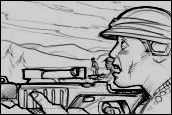 Work on the mission briefings is well underway. Craig wrote up scripts for mission briefings, based on what he’d received from the mission design specs. These scripts were taken up to the sound department where Marshall and Gavin worked with voice actors on take after take to get the speeches just right. There were no opportunities for volunteers as there sometimes are—I have done a couple of takes in the sound room in the past, but I fear my voice brims over with enthusiasm when I try out so my utility is limited—but that’s okay. I’m always a bit embarrassed to hear myself on these things anyway—it’s bad enough listening to myself on the answering machine.
Work on the mission briefings is well underway. Craig wrote up scripts for mission briefings, based on what he’d received from the mission design specs. These scripts were taken up to the sound department where Marshall and Gavin worked with voice actors on take after take to get the speeches just right. There were no opportunities for volunteers as there sometimes are—I have done a couple of takes in the sound room in the past, but I fear my voice brims over with enthusiasm when I try out so my utility is limited—but that’s okay. I’m always a bit embarrassed to hear myself on these things anyway—it’s bad enough listening to myself on the answering machine.
Next: the visuals. In KKND2 we are using fully-rendered 3D models rather than actors for the mission briefings. David W, Adam and Marnie created the 3D models used for the mission briefings, and they were animated to move their faces in a realistic manner using our own in-house facial motion capture tool FAMOUS. FAMOUS is a mixture of hardware and software which allows facial motion to be captured in real-time. Basically what happens is that the face whose motion is to be captured is plastered with reflective dots. As the face moves, the points on the face with dots catch the light and the distance and direction they have moved are instantly translated onto the on-screen model’s equivalent facial points. Obviously it’s not that simple as the rest of the on-screen model’s face must be appropriately contorted, but you get the basic idea. (There’s this great photo I have someplace that I clipped out of the newspaper here of Craig the designer in the FAMOUS getup. Craig is always larger than life—it’s part of what makes him the funniest guy I know—and his exaggerated expressions are really perfect for FAMOUS to home in on.) Glen H and Thomas have set up and supervised the facial actors and the output from FAMOUS is being sent back to the artists to touch up the frames as necessary and render out the final mission briefing.
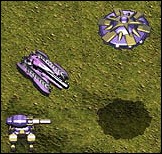 The intro sequence is being done by Chris, and the three end sequences by Sam, Brendan and Domenic. They create and animate the wire frame models, frame by frame, as well as creating and layering the backdrops. Lighting and point-of-view can be set within the 3D software which really helps the sequence’s composition, but I believe these guys do composition and cutting as well as any experienced film maker. They then render out each frame at the rate of one frame very two hours, and that’s using a render farm of 8 processors. It’s a slow process! The intro sequence is the longest we’ve ever attempted—three and a half minutes in all. When Chris and the others finish an FMV scene, work in the KKND2 room stops as everyone crowds around one terminal to view it over and over. I haven’t seen nearly all of the parts that make up these sequences, but every piece I’ve seen has been realistic and evocative. I’ve just seen one where a mute gets squashed like a bug under tank treads. Gross! Great! And this is before sound has been added.
The intro sequence is being done by Chris, and the three end sequences by Sam, Brendan and Domenic. They create and animate the wire frame models, frame by frame, as well as creating and layering the backdrops. Lighting and point-of-view can be set within the 3D software which really helps the sequence’s composition, but I believe these guys do composition and cutting as well as any experienced film maker. They then render out each frame at the rate of one frame very two hours, and that’s using a render farm of 8 processors. It’s a slow process! The intro sequence is the longest we’ve ever attempted—three and a half minutes in all. When Chris and the others finish an FMV scene, work in the KKND2 room stops as everyone crowds around one terminal to view it over and over. I haven’t seen nearly all of the parts that make up these sequences, but every piece I’ve seen has been realistic and evocative. I’ve just seen one where a mute gets squashed like a bug under tank treads. Gross! Great! And this is before sound has been added.
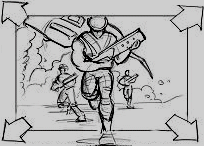 The new sidebar design is now complete. It’s a simplified, streamlined construct that won’t distract you from the game in progress. Production functions are now at the top as they’re the most-used parts of the bar. Dan is responsible for the final look and layout of the bar and Damien is designing the look of the interface in general. Toby is fiddling with the sidebar icons—his eagle eyes have caught a pixel out of place and instantly he’s zoomed in on the problem to smooth the right edge of the building icon. Other artists casually stand around watching and point out possible improvements: “those towers are too squat”. They’re talking about 5 pixels, total. Ah, the life of an artist! So much patience; so much eyestrain!
The new sidebar design is now complete. It’s a simplified, streamlined construct that won’t distract you from the game in progress. Production functions are now at the top as they’re the most-used parts of the bar. Dan is responsible for the final look and layout of the bar and Damien is designing the look of the interface in general. Toby is fiddling with the sidebar icons—his eagle eyes have caught a pixel out of place and instantly he’s zoomed in on the problem to smooth the right edge of the building icon. Other artists casually stand around watching and point out possible improvements: “those towers are too squat”. They’re talking about 5 pixels, total. Ah, the life of an artist! So much patience; so much eyestrain!
Someone asked me about 21st Century units so I asked Dan. He says the units from the original KKND are still in KKND2, but there are two new units also, the dropship and the UFO. The dropship is a high-tech carrier. The UFO, well I almost died laughing seeing it in action for the first time. It “abducts” infantry units instead of killing them, and it has a mean lightning gun.
I just went up to the sound studio to hear some of the music we’re going to be using in KKND2. Marshall was pretty enthusiastic as Chris Gilbey, who’s a producer from Sydney, sent down a six minute track he reckoned was going to be perfect for the Evolved. Dark techno, lots of percussion, subtle variations all the way through.—it’s going to be very cool indeed. Now I hear there’s going to be a music CD for KKND2 - Marshall has done a couple of tracks and this Sydney bunch has composed a whole lot more. So you’ll get to hear our evocative in-game themes and rush out and buy the CD to hum along to in your car. Sounds cool to me.
This week Justin suggested the title KKND2: Rock Paper Scissors just to see what would happen. We hit him. A lot.
Part 8
 With the game nigh on complete, the latest executables have been made available to our Quality Assurance testers who are putting the game through its paces. There are two areas to test—the general game and missions. Mission testers get to play missions over and over to see where they break down. Relatively easily solved are things to do with the maps and mission design such as misplaced sprites: “I can walk right over this building—fix it!” or missions which are too hard, too easy or just don’t capture the tester’s interest. I say relatively because of course when the designer has to redesign a level from scratch to satisfy the QA testers this is really no walk in the park. One of the QAers, Glenn, has actually relocated his desk from the QA department so he can sit in the Designers’ room and get them to fix that sort of problem at once. Harder to relay to the programmers are integral problems within the missions such as discrepancies in relative strengths of units (units that are WAY too powerful, for instance) and fixing odd unit behaviour (like units running away when they shouldn’t, or attacking friends).
With the game nigh on complete, the latest executables have been made available to our Quality Assurance testers who are putting the game through its paces. There are two areas to test—the general game and missions. Mission testers get to play missions over and over to see where they break down. Relatively easily solved are things to do with the maps and mission design such as misplaced sprites: “I can walk right over this building—fix it!” or missions which are too hard, too easy or just don’t capture the tester’s interest. I say relatively because of course when the designer has to redesign a level from scratch to satisfy the QA testers this is really no walk in the park. One of the QAers, Glenn, has actually relocated his desk from the QA department so he can sit in the Designers’ room and get them to fix that sort of problem at once. Harder to relay to the programmers are integral problems within the missions such as discrepancies in relative strengths of units (units that are WAY too powerful, for instance) and fixing odd unit behaviour (like units running away when they shouldn’t, or attacking friends).
General testers do not have to cover every inch of mission terrain in the same way as mission testers, but they have to test every option on every screen in every part of the game. Is that multiplayer screen behaving a little oddly? Put it in the database. Waypoints not working? Database. As you can see, both kinds of testers’ jobs overlap. The QA database is where all the problems go that aren’t immediately fixable by the level designers. Testers have to enter their problem and categorize it according to how bad a problem it is. A crash bug has a seriousness of 1. The problems also have a priority associated with them but this is more likely to be put aside as a programmer may fix two related bugs in one sitting—one priority 1 and the other priority 5—because they are in the same bit of code.
As well as QA testers, we’re running a 50-person beta test. Beta testers will have their own database to put in their problems, but they will be focussing more on multi-play and general gameplay, and not so much on mission testing. While logistically difficult to set up a beta test, it is definitely worthwhile to see how people think your game is doing and help you out by finding bugs and suggesting improvements.
Management decided that we’d have a vote to decide what we should call KKND2. There have been a lot of complaints (and derision) about the suggested names so far, and I guess the idea was to put the matter to rest once and for all. After days of to-and-froing on our internal mailing list, we nutted out these contenders:
- KKND2: The Third Strike
- KKnD2: Berzerker Force!
- Kounterstrike
- Krush Kill and Konquer
- KKND2: Struggle for Domination
- The Seeds Of War
- 3 Worlds Kollide
- Unholy Trinity
- KKND2: The Enemy Within
- Three’s a Krowd
- Killing Kommotion
- Unlimited Kaos
- KKND2: S9
- KKND2: Total Kaos
- Kaos Konflict
- Kollision Kourse
Even with this substantial list we couldn’t decide. People voted for their own suggestions and made up new ones. It seemed that everyone had different ideas about what was required in a good title, and were generally pretty vehemently for or against the names suggested. Finally Paul Baulch said all the names sucked and suggested KKND2: Krossfire. No-one complained (maybe we were sick of arguing) so we quickly got logos and box mock-ups done by the artists and now it’s official. I actually quite like it.
The website’s nearly complete. We got Damien, the same artist responsible for a lot of the KKND2 options pages, to do the buttons and backgrounds, and Rowan designed the layout of the site—not the page layout, that was Adrian, our Internet head honcho. Now it’s just up to me to pull together all the remaining content we need and it’ll be done. It’s the Unit pages that are the time consuming ones—there are so many units in the game, and we’re doing a page for each! We’re hoping to keep the site updated with the latest AVIs, the latest info and the coolest competitions.
Now all we need to do—after KKND2 has passed testing—is burn the game to CD and get it duplicated, have the manual laid out and printed, and the game boxed, and we’ll be shipping this much-awaited game straight from the distributors to you. Then we can all take some time off. Perhaps.



